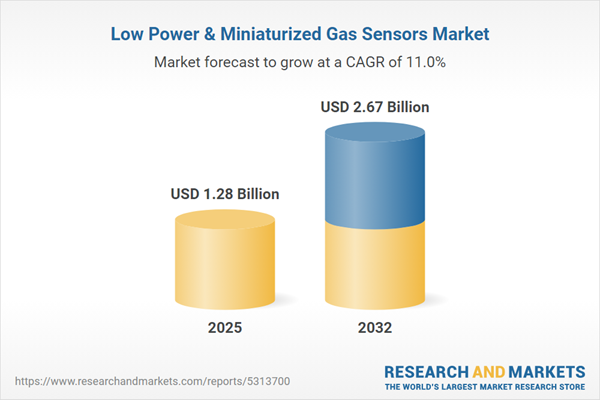Speak directly to the analyst to clarify any post sales queries you may have.
The low power and miniaturized gas sensors market is experiencing rapid transformation, with integrated sensing solutions enabling new applications across connected systems in multiple industries. As innovation in materials and system architectures converges with software advancements, market leaders are rethinking how sensing technologies deliver value at both the device and network levels.
Market Snapshot: Low Power and Miniaturized Gas Sensors
The global low power and miniaturized gas sensors market grew from USD 1.16 billion in 2024 to USD 1.28 billion in 2025. It is projected to continue its robust trajectory, achieving a compounded annual growth rate (CAGR) of 10.99% and reaching USD 2.67 billion by 2032. This expansion reflects increasing demand from sectors such as automotive, consumer electronics, healthcare, and industrial monitoring, driven by the continuous need for embedded, efficient, and reliable sensing solutions in real-world environments.
Scope & Segmentation
- Sensor Types: Electrochemical gas sensors, infrared gas sensors, solid-state gas sensors; each supports distinct balances among selectivity, miniaturization, and calibration requirements.
- Target Gases: Ammonia, butane, carbon dioxide, carbon monoxide, chlorine, hydrogen, hydrogen sulfide, methane, nitric oxide, nitrogen dioxide, oxygen, propane, refrigerant gas, sulfur dioxide; selection depends on regulatory, safety, and application priorities.
- End-Use Industries: Aerospace, automotive, consumer electronics, food & beverage, healthcare, military & defense; each presents unique integration, certification, and reliability needs.
- Applications: Air quality monitoring, gas leakage detection, smart home systems; these use cases shape requirements for power budgets, measurement cadence, and connectivity.
- Regional Coverage: Americas (United States, Canada, Mexico, Brazil, Argentina, Chile, Colombia, Peru), EMEA (United Kingdom, Germany, France, Russia, Italy, Spain, Netherlands, Sweden, Poland, Switzerland, United Arab Emirates, Saudi Arabia, Qatar, Turkey, Israel, South Africa, Nigeria, Egypt, Kenya), Asia-Pacific (China, India, Japan, Australia, South Korea, Indonesia, Thailand, Malaysia, Singapore, Taiwan).
- Key Players: AerNos, Inc., Aeroqual Limited, Amphenol Corporation, Crowcon Detection Instruments Ltd., Drägerwerk AG & Co. KGaA, Figaro Engineering Inc., Honeywell International Inc., Industrial Scientific Corporation, Infineon Technologies AG, Ion Science Ltd., Teledyne Technologies Incorporated, MSA Safety Incorporated, Robert Bosch GmbH, Senseair AB, Sensirion AG, SGX Sensortech Ltd., STMicroelectronics N.V., TDK Corporation, Vaisala Oyj, Zhengzhou Winsen Electronics Technology Co., Ltd.
Key Takeaways for Senior Decision-Makers
- The sector’s evolution is strongly influenced by advances in sensing materials, MEMS technologies, and AI-supported signal processing, which collectively extend device longevity and efficiency while enabling batch production.
- Manufacturers and OEMs are focused on balancing sensitivity, selectivity, and operational cost against product reliability, with emphasis on streamlining integration for both consumer and industrial deployments.
- Strategic procurement is adapting to changing supply chain realities, emphasizing diversification, alternate sourcing, and design flexibility to manage policy-driven volatility.
- Regional approaches differ: Americas emphasize local supplier qualification; EMEA prioritizes certification for public procurement and compliance; Asia-Pacific benefits from immediate manufacturing scale but faces shifts in sourcing as trade policies evolve.
- Companies combining robust hardware with adaptable software—and embedding clear certification pathways—are better placed to secure major contracts, especially in regulated and institutional markets.
Tariff Impact
Recent US tariff measures through 2025 have added operational complexity for market participants by raising input cost volatility and introducing compliance uncertainties. Organizations have responded by reconfiguring their supply chains to reduce dependence on tariff-sensitive components, investing in alternative sourcing outside traditional geographies, and increasing nearshoring activity for critical materials and subassemblies. These tactics strengthen supply resilience but impact cost structures and timelines. Close management of certification and accelerated qualification of alternative suppliers are now key imperatives.
Methodology & Data Sources
This analysis uses a mixed-methods approach. Structured interviews with suppliers, OEM integrators, and validation experts are complemented by secondary research, including technical documentation reviews and standards analysis. Triangulation and peer review ensure accuracy and depth across key technology and supply chain themes.
Why This Report Matters
- Enables benchmarking of technology choices and integration strategies for organizations seeking sustainable differentiation in the low power and miniaturized gas sensors market.
- Supports risk mitigation in procurement and supply chain decision-making by clarifying tariff impacts and outlining practical diversification strategies.
- Helps align product development with regional market requirements and regulatory frameworks for streamlined entry and long-term value capture.
Conclusion
Senior leaders equipped with this strategic insight can navigate technical, regulatory, and supply challenges to successfully deploy advanced gas sensors at scale. Prioritizing integration, resilience, and software innovation will define those positioned for long-term growth in a rapidly evolving global market.
Additional Product Information:
- Purchase of this report includes 1 year online access with quarterly updates.
- This report can be updated on request. Please contact our Customer Experience team using the Ask a Question widget on our website.
Table of Contents
3. Executive Summary
4. Market Overview
7. Cumulative Impact of Artificial Intelligence 2025
Companies Mentioned
The companies profiled in this Low Power & Miniaturized Gas Sensors market report include:- AerNos, Inc.
- Aeroqual Limited
- Amphenol Corporation
- Crowcon Detection Instruments Ltd.
- Drägerwerk AG & Co. KGaA
- Figaro Engineering Inc.
- Honeywell International Inc.
- Industrial Scientific Corporation
- Infineon Technologies AG
- Ion Science Ltd.
- Teledyne Technologies Incorporated
- MSA Safety Incorporated
- Robert Bosch GmbH
- Senseair AB
- Sensirion AG
- SGX Sensortech Ltd.
- STMicroelectronics N.V.
- TDK Corporation
- Vaisala Oyj
- Zhengzhou Winsen Electronics Technology Co., Ltd.
Table Information
| Report Attribute | Details |
|---|---|
| No. of Pages | 190 |
| Published | November 2025 |
| Forecast Period | 2025 - 2032 |
| Estimated Market Value ( USD | $ 1.28 Billion |
| Forecasted Market Value ( USD | $ 2.67 Billion |
| Compound Annual Growth Rate | 10.9% |
| Regions Covered | Global |
| No. of Companies Mentioned | 21 |









